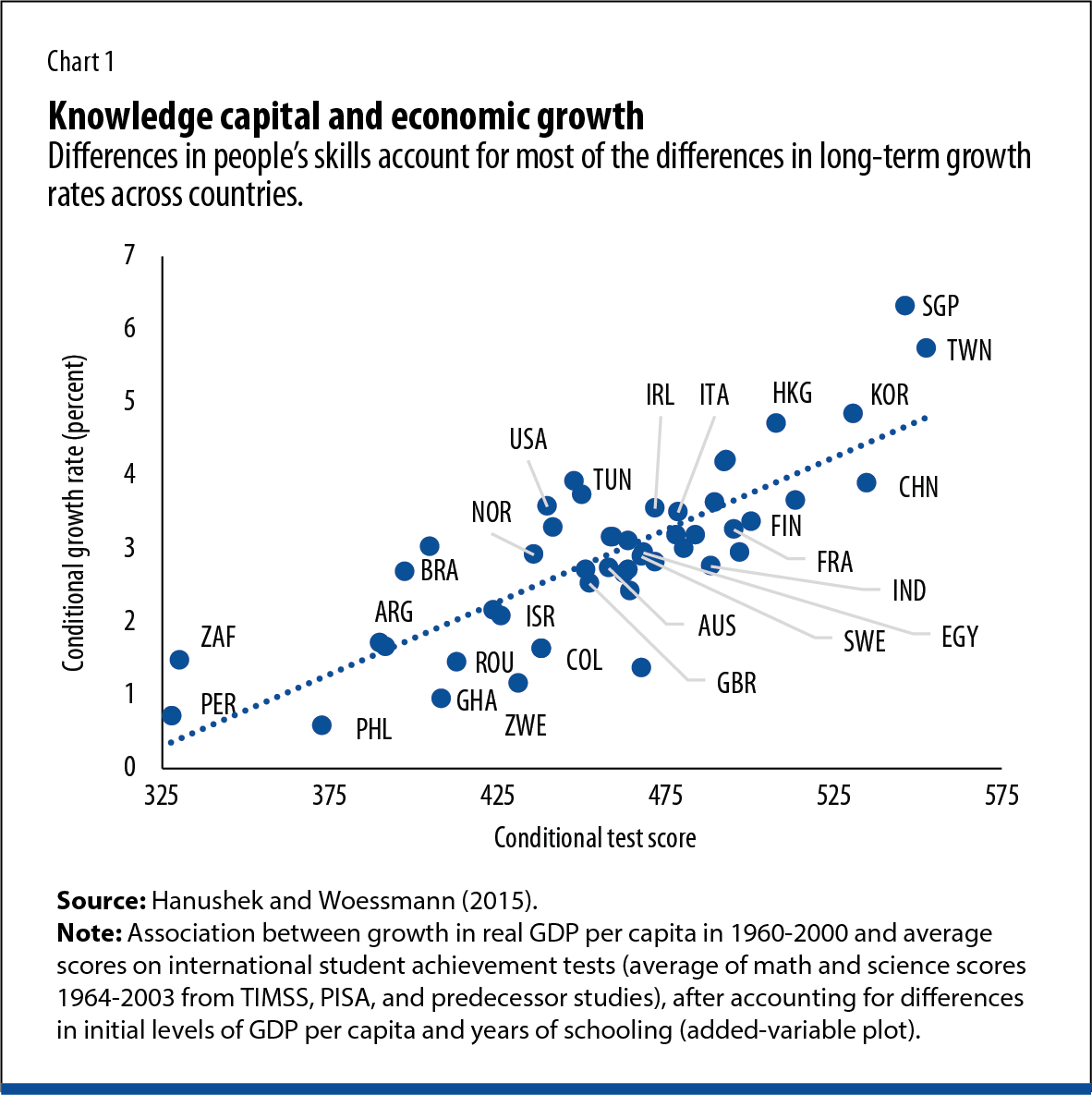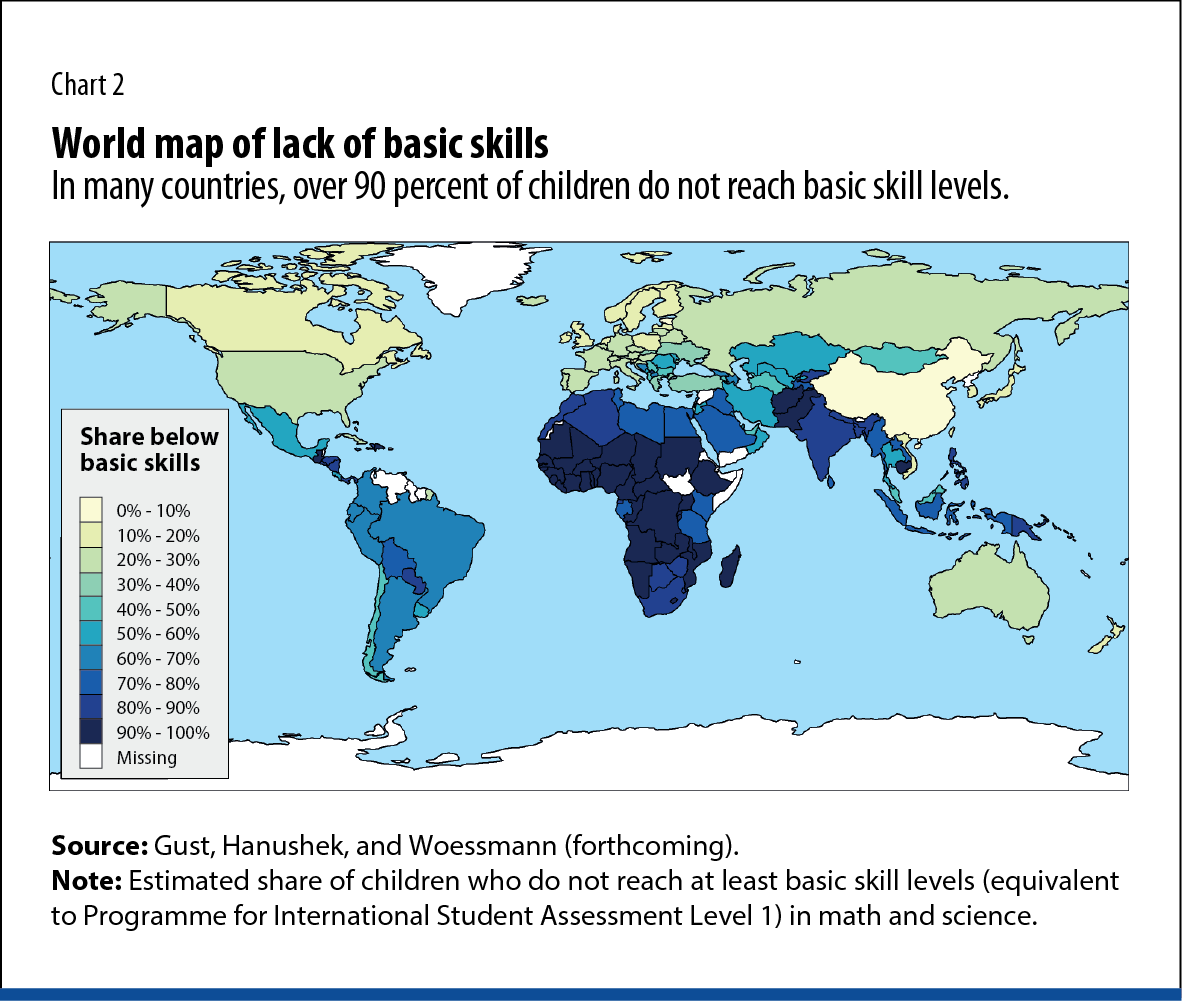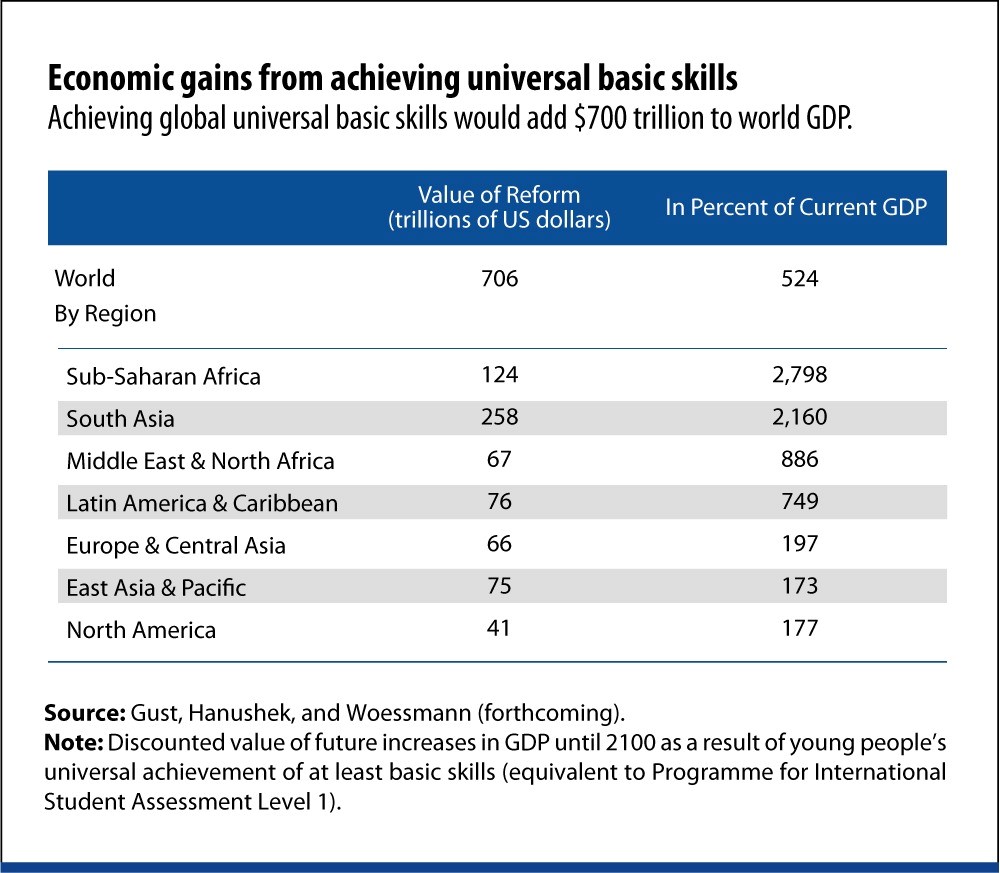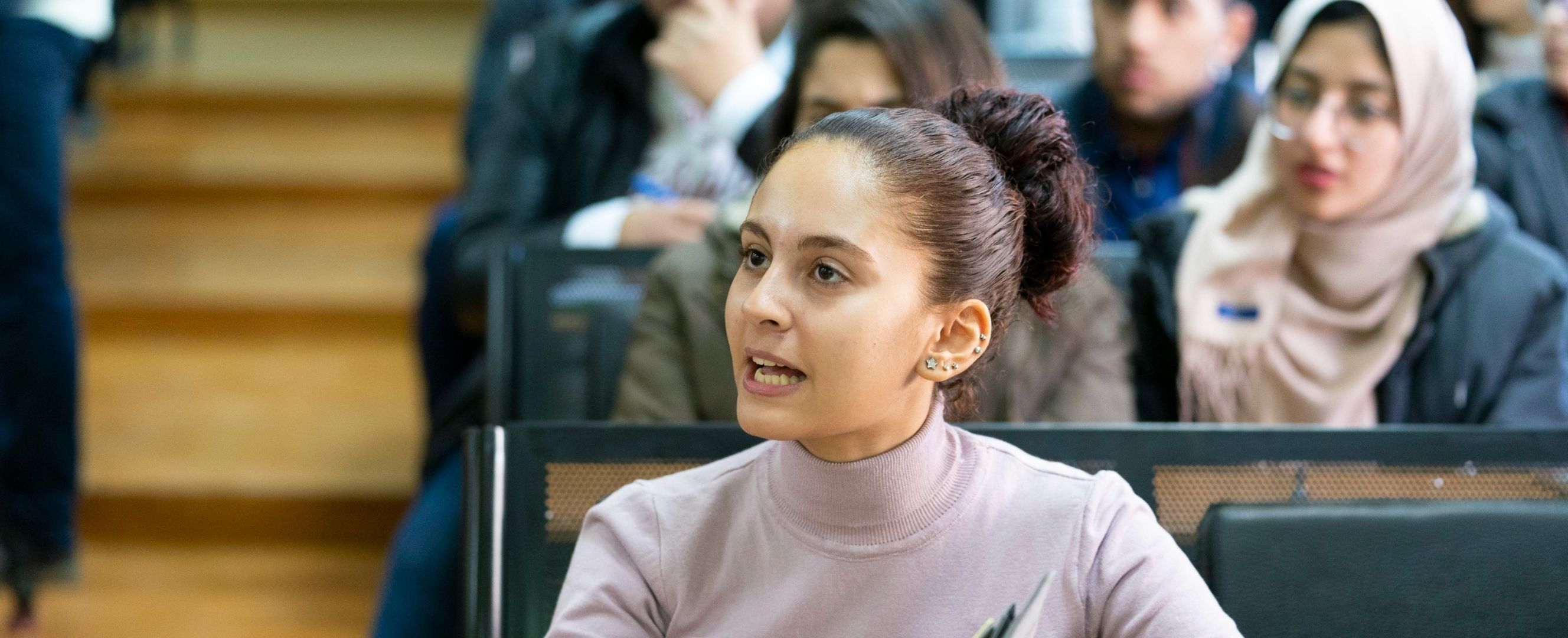April 26, 2022
Meeting the SDGs is impossible without global universal basic skills, still a faraway goal
The United Nations Sustainable Development Goals (SDGs) have received considerable attention since their adoption in 2015. But halfway through their implementation period there is little indication that the ambitious agenda will be accomplished by 2030. The key to bringing about the 17 SDGs is enhanced world development that provides the resources needed to move forward on the goals, but there is a fundamental challenge. Economic development depends on the skills of each society, which means that high-quality, equitable education is paramount. On this score, it is hard to be optimistic, because the deficits are large, and recent events have not improved the chances for success.
Based on the available evidence, we highlight three key issues: (1) Skill differences account for three-quarters of cross-country variations in long-term growth. (2) The global skill deficit is immense, as two-thirds or more of the world’s youth do not reach even basic skill levels. (3) Accordingly, reaching the goal of global universal basic skills would raise future world GDP by $700 trillion over the remainder of the century.
Achievement and growth
Understanding the determinants of economic growth has been the subject of considerable research. Our interpretation of the pattern of economic growth and development is straightforward: although a number of factors enter into short-term growth, in the long run growth depends primarily on the skills of the people (Hanushek and Woessmann 2015). In addition, our analysis indicates that the relevant economic skills are captured quite well by international student achievement tests in math and science.
The relationship between long-term growth and achievement is easiest to see in Chart 1. The skills of the population are measured by scores on international student assessments (for example, the Programme for International Student Assessment [PISA], the Trends in International Mathematics and Science Study [TIMSS], and their predecessors). The plot shows growth in GDP per capita during 1960–2000 after filtering out variation as a result of each country’s starting income level (since it is easier to imitate technology developed elsewhere than to innovate). Growth and achievement are closely linked: countries with high-achieving populations grew fast; those whose people lag in achievement hardly grew at all. Achievement explains three-quarters of the variation in growth rates across countries. Moreover, years of schooling have no bearing on growth after accounting for what has actually been learned.

The standard concern about such a picture is that it might not represent a causal relationship because other factors may be more important and are simply correlated with achievement. We have investigated other possible explanations in depth (Hanushek and Woessmann 2015), and—while it is impossible to remove all doubt—we show a credible case that lifting achievement has a powerful impact on growth. We find, for example, that achievement tests up to the early 1980s predict subsequent growth (which rules out simple reverse causation) and that greater spending (which may come from faster growth) does not consistently raise achievement. Furthermore, if we use only part of the achievement variation that emerged from good institutions of the school system, such as strong accountability measures or more school choice, we find the same link to faster growth, which rules out the notion that higher achievement simply captures omitted factors from outside the school system. And we find that countries with increased achievement over time have subsequently shown increased growth rates, thus dealing with potential omitted cultural or institutional factors.
The world picture of education
Tracking success in the area of education has historically been difficult. International achievement tests were first developed in the 1960s—and all rich countries are now participating regularly—but a majority of poor countries have never participated. A series of parallel regional tests have been developed, but they lack direct linkages to the broader-scale international assessments. And many countries, including the two most populace, have not produced student outcome data in a consistent manner.
In our most recent research, we bring the different international and regional assessments of student achievement together (Gust, Hanushek, and Woessmann, forthcoming). While some uncertainty remains, we characterize the world pattern of achievement and skills with sufficient accuracy to permit addressing the state of the world with respect to the SDGs.
We define basic skills as the skills necessary to participate productively in modern economies. Pragmatically, we assume these to be represented by mastering at least the lowest of the six skill levels of the international PISA test—that is, PISA Level 1 skills. Students at this level are able to carry out obvious routine procedures according to direct instructions, but they cannot draw direct inferences or reliably employ basic conventions to solve simple problems involving whole numbers. Such basic skills are a key foundation not only for participating in modern societies, but also for engaging in lifelong learning as is necessary in an ever changing world.
The picture that emerges from our analysis is disturbing. Two-thirds or more of the world’s young people fail to reach the minimum skill levels required to compete in the international economy. These deficits are found worldwide, but are most severe in the poorest countries—as shown in Chart 2.

Six stylized facts summarize the development challenges presented by global deficits in basic skills:
- At least two-thirds of the world’s youth do not obtain basic skills.
- The share of young people who do not reach basic skills exceeds half in 101 countries and rises above 90 percent in 37 of these.
- Even in high-income countries, a quarter of young people lack basic skills.
- Skill deficits reach 94 percent in sub-Saharan Africa and 90 percent in south Asia, but they also hit 70 percent in Middle East and North Africa and 66 percent in Latin America.
- While skill gaps are most apparent for the third of global youth not attending secondary school, fully 62 percent of the world’s secondary school students fail to reach basic skills.
- Half of the world’s young people live in the 35 countries that do not participate in international testing, resulting in a lack of regular foundational performance information.
The implication of the current state of achievement is that true world development will require major changes in the schools available to a majority of current and future students. It is not enough for all young people to be in school (as emphasized by the SDG for education), because the key issue is the low quality of education in most developing economies. This message is not a complete surprise, as seen from the policy discussions leading up to the SDGs. The urgency of this message is, however, heightened by the pandemic, which has impeded holding onto past outcomes, let alone moving forward.
The economics of meeting the SDGs
The primary development goal should be to endow all children (universal) in all countries (global) with at least basic skills. Global universal basic skills would lead to dramatic increases in world income. People with greater skills would see improved lifetime incomes. The aggregate impact would be even more dramatic.
Developed economies and international aid organizations have worked to improve developing economies. In 2020, more than $161 billion was disbursed under official development assistance. The effectiveness of these efforts has been frequently criticized, largely on empirical grounds that development in general had been slow.
We have calculated the economic value of erasing the learning deficits through actions to bring all youth up to basic skill levels (see table). This calls for secondary schooling for all young people that is good enough to equip them with basic skills. We use the growth relationship in Chart 1 to simulate the impact of this effort, allowing for time to improve the schools and discounting gains that are far in the future (Gust, Hanushek, and Woessmann, forthcoming).
The results are staggering. As the table indicates, the present value of added world GDP that would accrue over the remainder of the century is $700 trillion, or five times current annual world GDP. The gain is equivalent to 11 percent of the discounted future GDP over the same horizon. The impact on the concentrated developing regions of the world—sub-Saharan Africa, south Asia, the Middle East and North Africa, and Latin America—would be multiples of their current GDP.

Clearly such improvements in schools would be difficult to achieve, and it would take time for the economies to assimilate the newly skilled workforces. But the enormous gains show the imperative of attention to building a first-rate labor force. In terms of the larger picture, education-led development offers the possibility of meeting the various SDGs.
The new urgency
The previous picture considers the pre-pandemic world. The pandemic has universally changed the educational outcomes of the current cohorts of students. Losses as a result of school closures and reluctance to return to the classroom will not disappear simply by restoring schools to their January 2020 performance ( Hanushek and Woessmann 2020).
What’s even worse, there is mounting evidence that the learning losses from the pandemic have been disproportionately severe for poor children—those in developed economies and the large number in developing economies. Consistent with the prior analysis, however, the disruptions were greatest in a broad set of developing economies. Not only were schools closed for longer periods in those regions—up to a record-breaking two years in Uganda—but options to replace traditional in-person classes were more limited. Schools must be better than they were at the beginning of 2020 if they are to recover from the setbacks of the pandemic.
The key to improvement is an unwavering focus on the policy goal: improving student achievement. There is no obvious panacea, and effective policies may differ according to context. But the evidence points to the importance of focusing on incentives related to educational outcomes, which is best achieved through the institutional structures of the school system. Notably, education policies that develop effective accountability systems, promote choice, emphasize teacher quality, and provide direct rewards for good performance offer promise, supported by evidence.
Most obviously, the neediest countries are flying blind, with no information about their current achievement status. International development organizations should institute a regular, internationally standardized test in all countries of the global South, with tested content that is relevant for children who struggle to reach basic levels. Such a globally comparative test would give policymakers much better information so that they can focus their energy and devise suitable policies—and know if they are succeeding.
Opinions expressed in articles and other materials are those of the authors; they do not necessarily reflect IMF policy.
References:
Gust, Sarah, Eric A. Hanushek, and Ludger Woessmann. Forthcoming. "Global Universal Basic Skills: Current State and Implications for World Development."
Hanushek, Eric A., and Ludger Woessmann. 2015. The Knowledge Capital of Nations: Education and the Economics of Growth. Cambridge, MA: MIT Press.
Hanushek, Eric A., and Ludger Woessmann. 2020. The Economic Impacts of Learning Losses. Paris: Organisation for Economic Co-operation and Development.










